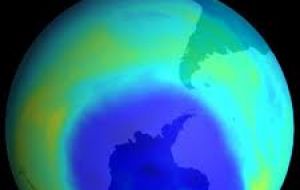MercoPress. South Atlantic News Agency
Ozone layer future recovery linked to climate change, says reports
 A return to pre-1980 levels of ozone is expected around mid-century
A return to pre-1980 levels of ozone is expected around mid-century A report sponsored by the UN Environment Program finds that over the past decade, global ozone levels, and ozone levels in the Arctic and Antarctic regions are at a turnaround point -- no longer decreasing but not yet increasing.
The abundances of ozone-depleting substances in the atmosphere are responding as expected to the controls of the Montreal Protocol, with many now declining in both the lower and upper atmosphere.
By successfully controlling the emissions of ozone-depleting substances, the Montreal Protocol also has been beneficial for the climate, because many of these substances are heat trapping, or greenhouse, gases that are linked to Earth's warming.
“The Montreal Protocol has succeeded in protecting the ozone layer from much higher levels of depletion,” said A.R. Ravishankara, director of NOAA's Chemical Sciences Division and co-chair of the Scientific Assessment Panel that produced the report. “But the ozone layer will increasingly be influenced by other factors related to the changing climate.”
For example, climate change alters the atmosphere's temperature and circulation patterns, which in turn affect the processes that deplete the ozone layer. One projected outcome of this relationship is that ozone in the Arctic, where the most severe changes in climate are being observed, is projected to be more sensitive to climate changes than ozone in the Antarctic, where climate change is relatively less of an influence on the ozone layer.
Effects also work in reverse. Changes in the ozone layer have been linked to observed shifts in seasonal surface winds over the Southern Hemisphere, contributing to the Antarctic Peninsula warming and the high plateau cooling.
The Antarctic ozone hole was discovered in 1985. Soon after, scientists established that the recurring springtime ozone hole was caused by human-made substances such as chlorofluorocarbons, or CFCs, used in refrigeration and halons used in fire extinguishers. The findings became a “science success story” as governments recognized the need for measures to reduce the production and consumption of a number of CFCs, halons and other ozone-depleting substances.
The Montreal Protocol on Substances that Deplete the Ozone Layer was adopted in 1987 and came into force in 1989. It was designed so that the schedules for phasing out ozone-depleting substances could be revised based on periodic scientific and technological assessments, be amended or adjusted to introduce other kinds of control measures, and to add new controlled substances to the list. The 2010 scientific assessment just released provides information needed by the Protocol's decision-makers during the coming few years as they consider possible further actions to protect the ozone layer.
A return to pre-1980 levels of ozone is expected around mid-century in mid-latitude regions and the Arctic, with recovery in the Antarctic expected to follow later this century, according to the assessment.
The ozone layer's continued protection depends on future adherence to the provisions of the Montreal Protocol, as well as potential new influences, such as possible unintended consequences of proposals to deliberately add compounds to the atmosphere to counteract warming due to heat-trapping gases.
“The Montreal Protocol is doing what it was designed to do and we are seeing less of the ozone-depleting substances covered by the agreement,” said Ravishankara. “This has protected the ozone layer. But the atmosphere and climate are changing, so the ozone layer will not exactly retrace its steps.”
NOAA scientists and colleagues contributed findings that were critical to the assessment report. Namely, they led studies that determined the cause of the Antarctic ozone hole and elucidated the processes involved in ozone depletion in other regions of the globe. Teams have also tracked the state of the ozone layer and the abundances of ozone-depleting substances in the atmosphere, and modeled the past and projected future state of the ozone layer.
The 2010 assessment was conducted under the auspices of the United Nations Environment Programme and the World Meteorological Organization. It involved more than 300 international scientists as authors and reviewers.
The full report is posted on the UNEP website: http://www.unep.ch/ozone/Assessment_Panels/SAP/index.shtml




Top Comments
Disclaimer & comment rules-

Read all commentsFor public consumption it is usually stated that the Ozone hole was first discovered in 1985, by British scientists Joseph Farman, Brian Gardiner, and Jonathan Shanklin of the British Antarctic Survey, although NASA stake a claim for two years earlier.
Feb 19th, 2011 - 12:43 am 0However on the BAS website it states that they have been monitoring ozone in the Antarctic since 1956. One wonders why, in all that time, they found no problem, when CFC’s had been in use for refrigeration since the 1930’s.
”Atmospheric ozone is measured in Dobson Units, (DU), during the International Geophysical Year of 1956 there was a significant increase in the number of these devices in use around the globe and the Halley Bay (Antarctica) anomaly was discovered.”
The BAS web site has data for 2009-10 and reports that:
“Ozone values dropped, to reach a minimum of around 125 DU (60% depletion) in late September, (Antarctic spring). The lowest daily value measured was 107 DU on October 1. This minimum value is similar to those recorded each October since the early 1990s.”
It is also similar to those in the spring of 1958 at the French Antarctic Observatory at Dumont d'Urville [opposite side of the South Pole from Halley Bay], when Rigaud and Leroy [quoted in Annales Geophysicae (November, 1990)] reported atmospheric ozone levels as low as 110 DU.
Volcanoes produce a variety of halocarbons, including CFCs. Other natural sources of CFCs include sponges, other marine animals, bacteria (both marine & terrestrial), fungi (both marine & terrestrial), plants (both marine & terrestrial), lichen and insects. In 2007, the British Antarctic Survey found large quantities of ozone-depleting halogens produced by the action of sunlight on sea water. The ozone thinning is an annual event, it is a natural cycle.
Commenting for this story is now closed.
If you have a Facebook account, become a fan and comment on our Facebook Page!